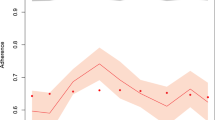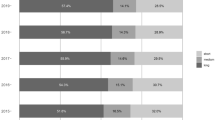Abstract
Purpose
The purpose of this study are to analyse adherence to antidepressant treatment over 2 years in Sweden among women and men who initiated treatment with citalopram and to identify groups at risk of non-adherence using trajectory models.
Methods
The study population, including individuals 18–85 years who initiated citalopram use between 1 July 2006 and 30 June 2007, was identified in the Swedish Prescribed Drug Register and followed for 2 years. Adherence was estimated with continuous measure of medication acquisition (CMA) and group-based trajectory modelling, a method which describes adherence patterns over time by estimating trajectories of adherence and the individual’s probability of belonging to a specific trajectory.
Results
The study population included 54,248 individuals, 64 % women. Mean CMA was 52 % among women and 50 % among men (p < 0.001). Five different adherence patterns (Trajectories) were identified. Similar proportion of women and men belonged to each Trajectory. Around 29 % of the women and 27 % of the men belonged to the Trajectory which showed full adherence throughout the 2-year study period. The other four Trajectories showed adherence that declined to different degrees and at different stages in time. Having low socioeconomic status was more common among individuals in Trajectories showing declining adherence than in the adherent Trajectory.
Conclusions
Using trajectory modelling, five Trajectories describing different patterns of adherence to citalopram treatment over time were identified. A large proportion discontinued treatment early and having low socioeconomic status increased the risk of being non-adherent.


Similar content being viewed by others
References
The National Board of Health and Welfare (2010) Nationella riktlinjer för vård vid depression och ångesyndrom 2010 - stöd för styrning och ledning (In English: National guidelines for the care of depression and anxiety syndroms 2010). Stockholm
National Institute for Health and Clinical Excellence (2009) Depression in adults: the treatment and management of depression in adults. NHS
Bauer M, Bschor T, Pfennig A, Whybrow P, Angst J, Versiani M, et al. (2007) World Federation of Societies of Biological Psychiatry (WFSBP) guidelines for biological treatment of unipolar depressive disorders in primary care. World J Biol Psychiatry 8:67–104
National Institute for Health and Care Excellence (2011) Generalised anxiety disorder and panic disorder in adults: management. NHS
Hansen HV, Kessing LV (2007) Adherence to antidepressant treatment. Expert Rev Neurother 7:57–62. doi:10.1586/14737175.7.1.57
Khandelwal N, Duncan I, Rubinstein E, Ahmed T, Pegus C, Murphy P, et al. (2011) Medication adherence for 90-day quantities of medication dispensed through retail and mail order pharmacies. Am J Manag Care 17:e427–e434
Tomasson K, Tomasson H, Zoega T, Sigfusson E, Helgason T (2007) Epidemiology of psychotropic medication use: comparison of sales, prescriptions and survey data in Iceland. Nord J Psychiatry 61:471–478. doi:10.1080/08039480701773311
Sansone RA, Sansone LA (2012) Antidepressant adherence: are patients taking their medications? Innov Clin Neurosci 9:41–46
Hansen RA, Dusetzina SB, Dominik RC, Gaynes BN (2010) Prescription refill records as a screening tool to identify antidepressant non-adherence. Pharmacoepidemiol Drug Saf 19:33–37. doi:10.1002/pds.1881
Lu CY, Roughead E (2012) New users of antidepressant medications: first episode duration and predictors of discontinuation. Eur J Clin Pharmacol 68:65–71. doi:10.1007/s00228-011-1087-3
Kales HC, Nease DE Jr, Sirey JA, Zivin K, Kim HM, Kavanagh J, et al. (2013) Racial differences in adherence to antidepressant treatment in later life. Am J Geriatr Psychiatry 21:999–1009. doi:10.1016/j.jagp.2013.01.046
Hansen DG, Vach W, Rosholm JU, Sondergaard J, Gram LF, Kragstrup J (2004) Early discontinuation of antidepressants in general practice: association with patient and prescriber characteristics. Fam Pract 21:623–629. doi:10.1093/fampra/cmh608
Sundell KA, Waern M, Petzold M, Gissler M (2013) Socio-economic determinants of early discontinuation of anti-depressant treatment in young adults. Eur J Pub Health 23:433–440. doi:10.1093/eurpub/ckr137
Bocquier A, Cortaredona S, Verdoux H, Casanova L, Sciortino V, Nauleau S, et al. (2014) Social inequalities in early antidepressant discontinuation. Psychiatr Serv 65:618–625. doi:10.1176/appi.ps.201300184
Hung CI (2014) Factors predicting adherence to antidepressant treatment. Curr Opin Psychiatry 27:344–349. doi:10.1097/yco.0000000000000086
Bogner HR, Lin JY, Morales KH (2006) Patterns of early adherence to the antidepressant citalopram among older primary care patients: the prospect study. Int J Psychiatry Med 36:103–119
Maddox TM, Ross C, Tavel HM, Lyons EE, Tillquist M, Ho PM, et al. (2010) Blood pressure trajectories and associations with treatment intensification, medication adherence, and outcomes among newly diagnosed coronary artery disease patients. Circ Cardiovasc Qual Outcomes 3:347–357. doi:10.1161/circoutcomes.110.957308
Franklin JM, Shrank WH, Pakes J, Sanfelix-Gimeno G, Matlin OS, Brennan TA, et al. (2013) Group-based trajectory models: a new approach to classifying and predicting long-term medication adherence. Med Care 51:789–796. doi:10.1097/MLR.0b013e3182984c1f
Lesen E, Sandstrom TZ, Carlsten A, Jonsson AK, Mardby AC, Sundell KA (2011) A comparison of two methods for estimating refill adherence to statins in Sweden: the RARE project. Pharmacoepidemiol Drug Saf 20:1073–1079. doi:10.1002/pds.2204
Jonsson AK, Schioler L, Lesen E, Andersson Sundell K, Mardby AC (2014) Influence of refill adherence method when comparing level of adherence for different dosing regimens. Eur J Clin Pharmacol 70:589–597. doi:10.1007/s00228-014-1649-2
The National Board of Health and Welfare (2009) Pharmaceuticals-statistics for 2008. Stockholm
Wettermark B, Hammar N, Fored CM, Leimanis A, Otterblad Olausson P, Bergman U, et al. (2007) The new Swedish prescribed drug register—opportunities for pharmacoepidemiological research and experience from the first six months. Pharmacoepidemiol Drug Saf 16:726–735. doi:10.1002/pds.1294
Burnett-Zeigler I, Kim HM, Chiang C, Kavanagh J, Zivin K, Rockefeller K, et al. (2014) The association between race and gender, treatment attitudes, and antidepressant treatment adherence. Int J Geriatr Psychiatry 29:169–177. doi:10.1002/gps.3984
Zimmer Z, Martin LG, Jones BL, Nagin DS (2014) Examining late-life functional limitation trajectories and their associations with underlying onset, recovery, and mortality. J Gerontol Ser B Psychol Sci Soc Sci 69:275–286. doi:10.1093/geronb/gbt099
Isacsson G, Boethius G, Henriksson S, Jones JK, Bergman U (1999) Selective serotonin reuptake inhibitors have broadened the utilisation of antidepressant treatment in accordance with recommendations. Findings from a Swedish prescription database. J Affect Disord 53:15–22
Gichangi A, Andersen M, Kragstrup J, Vach W (2006) Analysing duration of episodes of pharmacological care: an example of antidepressant use in Danish general practice. Pharmacoepidemiol Drug Saf 15:167–177. doi:10.1002/pds.1160
Johnell K, Fastbom J (2008) Multi-dose drug dispensing and inappropriate drug use: a nationwide register-based study of over 700,000 elderly. Scand J Prim Health Care 26:86–91. doi:10.1080/02813430802022196
Acknowledgments
The data collection for this work has been supported by the National Corporation of Swedish Pharmacies (Apoteket AB). The Swedish Medical Products Agency provided funding for this project for author AKJ, PJ, and for statistical assistance. The county council of Östergötland provided funding for this project for author AKJ.
Contribution of authors
A-CM, AKJ, KAS, PB, and EL conceived the study question. A-CM organised the study, interpreted the results, and drafted the manuscript. AKJ processed the data, conducted statistical analyses, interpreted the results, and drafted the manuscript. LS processed the data and conducted statistical analyses. PB validated the algorithm. LS, KAS, PB, and EL contributed to the interpretation of the results and critically revised the manuscript for important intellectual content. All authors have read and approved of the final manuscript.
Author information
Authors and Affiliations
Corresponding author
Ethics declarations
The study was performed in compliance with the Declaration of Helsinki from 1964 and its later amendments. The Regional Ethics Review Board in Gothenburg, Sweden, has approved the RARE-project before start, No. 284–09. With the ethics approval, the register data was retrieved from and linked together by the Statistics Sweden and Swedish National Board of Health and Welfare. The data was delivered in de-identified files with a random serial number instead of the personal identity numbers. In concordance with the ethics approval, no formal consent was obtained since the study only includes national register data. The results were analysed and reported on group level.
Competing interests
A-CM was employed by the Sahlgrenska University Hospital and University of Gothenburg when the study was conducted, and is today employed by Novo Nordisk A/S. EL is employed by Nordic Health Economics, a research and consultancy company, and has no competing interests or financial disclosures related to the current study. KAS was employed by the University of Gothenburg when the study was conducted, and is today employed by AstraZeneca AB. The authors’ work was independent from the employers. The authors have no conflict of interest to declare related to the study question or the results presented.
Rights and permissions
About this article
Cite this article
Mårdby, AC., Schiöler, L., Sundell, K.A. et al. Adherence to antidepressants among women and men described with trajectory models: a Swedish longitudinal study. Eur J Clin Pharmacol 72, 1381–1389 (2016). https://doi.org/10.1007/s00228-016-2106-1
Received:
Accepted:
Published:
Issue Date:
DOI: https://doi.org/10.1007/s00228-016-2106-1




